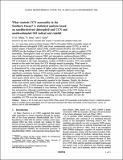Por favor, use este identificador para citar o enlazar a este item:
http://hdl.handle.net/10261/27309COMPARTIR / EXPORTAR:
 SHARE SHARE
 CORE
BASE CORE
BASE
|
|
| Visualizar otros formatos: MARC | Dublin Core | RDF | ORE | MODS | METS | DIDL | DATACITE | |

| Título: | What controls CCN seasonality in the Southern Ocean? A statistical analysis based on satellite-derived chlorophyll and CCN and model-estimated OH radical and rainfall |
Autor: | Vallina, Sergio M. CSIC ORCID; Simó, Rafel CSIC ORCID ; Gassó, S. | Fecha de publicación: | mar-2006 | Editor: | American Geophysical Union | Citación: | Global Biogeochemical Cycles 20(1): GB1014 (2006) | Resumen: | A 3-year time series set (from January 2002 to December 2004) of monthly means of satellite-derived chlorophyll (CHL) and cloud condensation nuclei (CCN), as well as model outputs of hydroxyl radical (OH), rainfall amount (RAIN), and wind speed (WIND) for the Southern Ocean (SO, 40°S–60°S) is analyzed in order to explain CCN seasonality. Chlorophyll is used as a proxy for oceanic dimethylsulfide (DMS) emissions since both climatological aqueous DMS and atmospheric methanesulfonate (MSA) concentrations are tightly coupled with chlorophyll seasonality over the Southern Ocean. OH is included as the main atmospheric oxidant of DMS to produce CCN, and rainfall amount as the main loss factor for CCN through aerosol scavenging. Wind speed is used as a proxy for sea salt (SS) particles production. The CCN concentration seasonality is characterized by a clear pattern of higher values during austral summer and lower values during austral winter. Linear and multiple regression analyses reveal high significant correlations between CCN and the product of chlorophyll and OH (in phase) and rainfall amount (in antiphase). Also, CCN concentrations are anticorrelated with wind speed, which shows very little variability and a slight wintertime increase, in agreement with the sea salt seasonality reported in the literature. Finally, the fraction of the total aerosol optical depth contributed by small particles (ETA) exhibits a seasonality with a 3.5-fold increase from austral winter to austral summer. The biogenic contribution to CCN is estimated to vary between 35% (winter) and 80% (summer). Sea salt particles, although contributing an important fraction of the CCN burden, do not play a role in controlling CCN seasonality over the SO. These findings support the central role of biogenic DMS emissions in controlling not only the number but also the variability of CCN over the remote ocean | Descripción: | 13 pages, 4 figures | Versión del editor: | https://doi.org/10.1029/2005GB002597 | URI: | http://hdl.handle.net/10261/27309 | DOI: | 10.1029/2005GB002597 | ISSN: | 0886-6236 |
| Aparece en las colecciones: | (ICM) Artículos |
Ficheros en este ítem:
| Fichero | Descripción | Tamaño | Formato | |
|---|---|---|---|---|
| Vallina_et_al_2006.pdf | 535,22 kB | Adobe PDF |  Visualizar/Abrir |
CORE Recommender
SCOPUSTM
Citations
85
checked on 11-abr-2024
WEB OF SCIENCETM
Citations
80
checked on 23-feb-2024
Page view(s)
310
checked on 19-abr-2024
Download(s)
240
checked on 19-abr-2024
Google ScholarTM
Check
Altmetric
Altmetric
NOTA: Los ítems de Digital.CSIC están protegidos por copyright, con todos los derechos reservados, a menos que se indique lo contrario.
